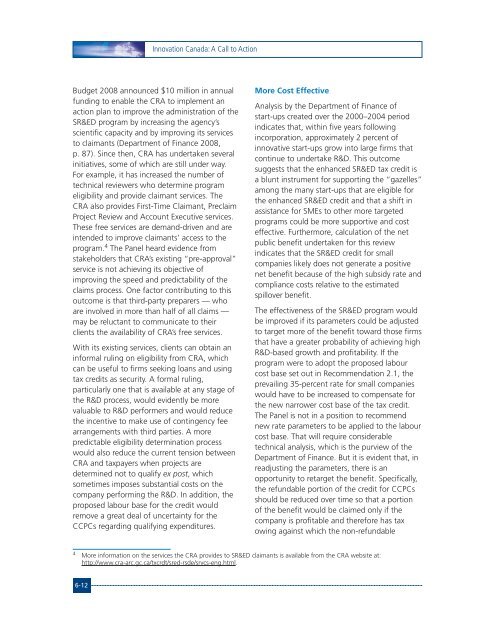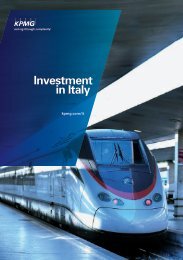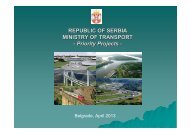Innovation Canada: A Call to Action
Innovation Canada: A Call to Action
Innovation Canada: A Call to Action
Create successful ePaper yourself
Turn your PDF publications into a flip-book with our unique Google optimized e-Paper software.
<strong>Innovation</strong> <strong>Canada</strong>: A <strong>Call</strong> <strong>to</strong> <strong>Action</strong>Budget 2008 announced $10 million in annualfunding <strong>to</strong> enable the CRA <strong>to</strong> implement anaction plan <strong>to</strong> improve the administration of theSR&ED program by increasing the agency’sscientific capacity and by improving its services<strong>to</strong> claimants (Department of Finance 2008,p. 87). Since then, CRA has undertaken severalinitiatives, some of which are still under way.For example, it has increased the number oftechnical reviewers who determine programeligibility and provide claimant services. TheCRA also provides First-Time Claimant, PreclaimProject Review and Account Executive services.These free services are demand-driven and areintended <strong>to</strong> improve claimants’ access <strong>to</strong> theprogram. 4 The Panel heard evidence fromstakeholders that CRA’s existing “pre-approval”service is not achieving its objective ofimproving the speed and predictability of theclaims process. One fac<strong>to</strong>r contributing <strong>to</strong> thisoutcome is that third-party preparers — whoare involved in more than half of all claims —may be reluctant <strong>to</strong> communicate <strong>to</strong> theirclients the availability of CRA’s free services.With its existing services, clients can obtain aninformal ruling on eligibility from CRA, whichcan be useful <strong>to</strong> firms seeking loans and usingtax credits as security. A formal ruling,particularly one that is available at any stage ofthe R&D process, would evidently be morevaluable <strong>to</strong> R&D performers and would reducethe incentive <strong>to</strong> make use of contingency feearrangements with third parties. A morepredictable eligibility determination processwould also reduce the current tension betweenCRA and taxpayers when projects aredetermined not <strong>to</strong> qualify ex post, whichsometimes imposes substantial costs on thecompany performing the R&D. In addition, theproposed labour base for the credit wouldremove a great deal of uncertainty for theCCPCs regarding qualifying expenditures.More Cost EffectiveAnalysis by the Department of Finance ofstart-ups created over the 2000–2004 periodindicates that, within five years followingincorporation, approximately 2 percent ofinnovative start-ups grow in<strong>to</strong> large firms thatcontinue <strong>to</strong> undertake R&D. This outcomesuggests that the enhanced SR&ED tax credit isa blunt instrument for supporting the “gazelles”among the many start-ups that are eligible forthe enhanced SR&ED credit and that a shift inassistance for SMEs <strong>to</strong> other more targetedprograms could be more supportive and costeffective. Furthermore, calculation of the netpublic benefit undertaken for this reviewindicates that the SR&ED credit for smallcompanies likely does not generate a positivenet benefit because of the high subsidy rate andcompliance costs relative <strong>to</strong> the estimatedspillover benefit.The effectiveness of the SR&ED program wouldbe improved if its parameters could be adjusted<strong>to</strong> target more of the benefit <strong>to</strong>ward those firmsthat have a greater probability of achieving highR&D-based growth and profitability. If theprogram were <strong>to</strong> adopt the proposed labourcost base set out in Recommendation 2.1, theprevailing 35-percent rate for small companieswould have <strong>to</strong> be increased <strong>to</strong> compensate forthe new narrower cost base of the tax credit.The Panel is not in a position <strong>to</strong> recommendnew rate parameters <strong>to</strong> be applied <strong>to</strong> the labourcost base. That will require considerabletechnical analysis, which is the purview of theDepartment of Finance. But it is evident that, inreadjusting the parameters, there is anopportunity <strong>to</strong> retarget the benefit. Specifically,the refundable portion of the credit for CCPCsshould be reduced over time so that a portionof the benefit would be claimed only if thecompany is profitable and therefore has taxowing against which the non-refundable4 More information on the services the CRA provides <strong>to</strong> SR&ED claimants is available from the CRA website at:http://www.cra-arc.gc.ca/txcrdt/sred-rsde/srvcs-eng.html.6-12
















